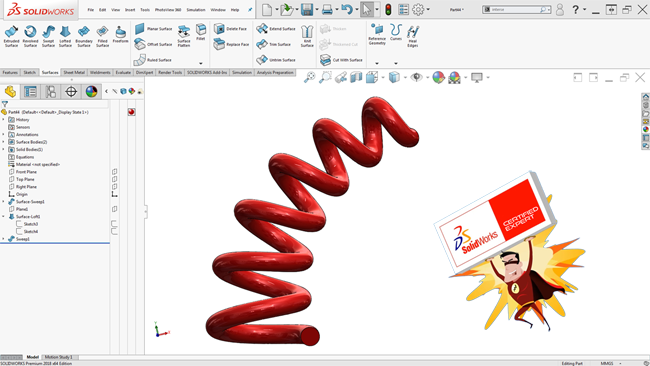
Hello Internet Traveler,
If you’re in the market for information on the CSWE (Certified SolidWorks Expert Exam), you’re probably finding that it’s a bit sparse out there.
SolidWorks is purposefully tight-lipped on what to expect on this exam, going as far as not even creating a simple sample exam for it. Their reasoning being, you’re supposed to be a SolidWorks Expert. You figure it out.
Fair Enough.
If you’re thinking, Rohit, just shut up and give me my sample problem already: Here, take it. (Jokes on you, now I have your email 😉 )
Oh, you weren’t thinking that? My bad. Let’s continue.
Let me give a brief overview of this post, so you can skip to what’s most relevant to you.
I’m going to start by giving my notes/thoughts and an outline for the CSWE. There will then be a youtube video linked on how to create a tapered and curved spring in SolidWorks. The tutorial has relevance to both the CSWE and the CSWPA Surfacing exams. Finally, there will be another link at the bottom to download a full practice problem.
1. What is the CSWE and how do you study for it?
The CSWE or Certified SolidWorks Expert exam is the highest level of certification you can get from SolidWorks and requires that you have both passed the CSWP exam and 4 of the 5 CSWPA (advanced topic exams) before you attempt it. You can find more information on the exam on SolidWorks’ website.
The list from the above link is a good starting point on what to study and gives you a general idea of what to expect without giving all that much away.
The easiest way to study for the exam is to go through my CSWE training course. It takes you step by step through exactly what you need to know for the exam.
You prefer the hard way, you say?
Alright, fair enough. Here are some notes to help you with the exam:
-SolidWorks has an “intended method” for every problem. If you can figure out how they want you to solve the problems, the exam is pretty easy. You should be able to solve the same problem in SolidWorks using a lot of different methods. If you’re too rigid and try to stick with more traditional ways of doing things in SolidWorks, you won’t fair well.
-Probably the most important tip: you should be comfortable modifying imported geometry. A Part File without a feature history should not scare you. Tools like Delete Face, Split, Move/Copy Bodies, and Combine should not sound foreign.
-Don’t be afraid to use google during the exam. Seriously, the first thing I did when attempting the exam was to watch a video on youtube about using the Belt and Chain functionality inside a sketch. I had studied Belts and Chains for assemblies and how to use sketch blocks, but I had not studied how to use the two together, within a sketch.
-Learn how to use the Path mate (cough, cough)
-Go through the CSWPA-Weldments sample exam The 3D sketching method you use in the practice is the same you’ll use on the CSWE.
-You should know how to link to custom properties in a Bill of Materials
-Watch the video below and attempt the practice problem at the bottom of this post.
-And finally, to quote the great Douglas Adams: “Don’t Panic.” You’ll have 4 hours to complete the exam. That’s a good amount of time. Look through the problems. Breathe. Then, get to work. As one of your teachers probably told you, if you don’t know how to answer the question, come back to it later.
2. Watch this video. Learn you some surfacing stuff.
Actually, before you watch the video, try to think of how you would create a curved spring in SolidWorks. By curved, I mean how would you create a helix that follows a sketch arc to create this spring. Then watch it:
3. Take your shot at a real live CSWE practice problem.
Without further ado, smash that download button below and give it a try:
Click Here to Get the CSWE Practice Problem